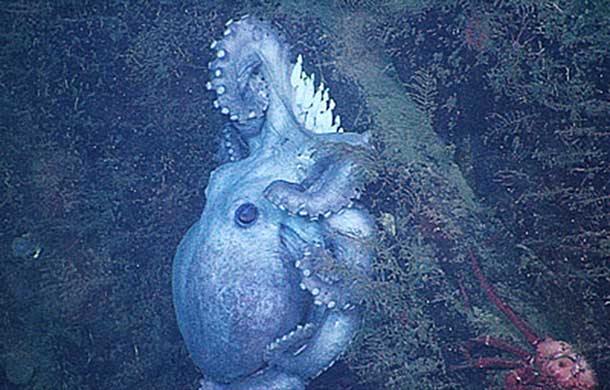
Mother Octopus dubbed Octo Mom
In the depths of the ocean Marine Biologists say creatures living there are some of the most fascinating on earth. This watery realm is the habitat of whales, dolphins, porpoises, sharks, sea otters, seals, walruses and the incredibly diverse jellyfish.
However one of the most fascinating is an Octopus (Latin, octo meaning eight. An octopus has eight tentacles). Once traveling a train in Oregon a couple of older railroad conductors were discussing younger days spent along the shores of the Columbia River.
Where they were aware octopuses were some 6 to 8 feet in length. That’s comparable to pioneers in Northwestern Ontario reporting giant size freshwater sturgeon.

There are something like 300 species of octopus living at sea.
The Minoans appreciated these amphibians with their whirling symmetrical extensions and tentacles. Their mystical octopus eyes that artisans, back then, painted on pottery.
It was Aristotle who noted how an octopus stalks its prey by intelligently changing its colour. Ancient Peruvians held octopus in esteem for their cleverness. Their sea faring people actually worshiped them. As have cultures stretching as far away as China, Thailand and the Philippines.
However this summer the Monterey Aquarium revealed an amazing narrative spanning over four incredible years.
Their researchers began a focus on a mother octopus that had located herself with a clutch of 155 eggs in the deep canyon waters (4,600 ft.) of Monterey Bay in central California.
Anyone travelling along the Pacific Rim to Monterey’s Aquarium knows the salient beauty of the world’s only Whale Museum built on pillars allowing whales and dolphins to swim into and out of the Aquarium’s location.
David Packard of Hewlett-Packard designed it.
It has become one of the most inspiring Marine Museums and Kelp Forest Preserves in the World. What is also connected to the following story is Monterey have, besides, a resident Octopus that brings commentaries you’ll hear in going there.
Visitors simply marvel at the variations of its colours and its fascinating construction.
An American poet wrote this after studying this unique creature. “It`s a blend of submarine delicacy. Every tentacle tapering to a whiplash point. Holding vision in an eye`s tight translucence. Almost a ghost among ghosts at home in the sea. Though it has drifted like this through eons in time. Gliding. Free. And, majestic. “
Meanwhile the Monterey Bay Research staff carried out 18 deep ocean journeys following this tiny octopus.
Known a as grenelone boreopacifica in the language of classifying by marine biologists. Right after the initial year researchers were so overwhelmingly intrigued they made certain they allotted time “to log in” viewing this valiant mother tending to her brood while they also pursued other research projects.
After the second, then, the third year they began to call her the Octo-Mum.
Other creatures in the Animal Kingdom such elephants have a gestation period as long as 21 months.
A shark may carry an internal embryo for over a year.
But nowhere has any brooding period been comparable to this tiny Octo-Mum.
Her size is comparable to a tiny rugby ball. Her arms spanning, when extended, to less than half a yard.
As researchers returned they verified who she was identifying small scar marks on her tentacles. Besides, she was eternally centred over her delivery of her eggs. She was also living in the coolest of seep ocean waters where the temperatures hovered at 3 C.
By the fourth season, and a short measure of time beyond, the Octo-Mum had finally accomplished her mission in life.
Once the eggs began evolving through this underwater incubation the mother octopus had realized her life’s journey. She just slipped away. She would pass on.
Her cycle was totally complete. And in the annals of scientific research she had so significantly perpetuated the longest study in motherhood ever catalogued.
When one thinks of the fact two thirds of our earth is water: Janet Voight of the Field Museum in Chicago wrote, ‘’what we know about shallow water octopus is they grow fast.
Though it is really amazing this Octo-Mum persisted so very long. Consuming so much organic, living time to her deep-sea den. In the end she had given everything. Over time her resources were completely drained out.“
Monterey`s Chief Marine Researcher Bruce Robison commented this species of Octopus will migrate as far North as 50 degrees latitude extending into Canada’s cool waters as far as southern British Columbia. Monterey’s staff began their study in 2007 then watched, plotted, and were overwhelmed by the Octo-Mum’s final weeks.
It was a life centred on her saga spanning right into 2011. Brent Seibel, of the University of Rhode Island, who took part in the deep dives with Robison reflected. “How a mothering creature survives that long is still the biggest mystery that was unfolding in our own journeys to her.“ There is an uplifting element to all this about the Octo-Mum.
She absolutely transcended the outer limits of caring. Her role was to comfort her clutch from any large prey or creeping, annoying crabs. She would also blow away any debris or sandy grit the wavy currents way down below might billow, in a twisting current, sending that particulate matter up to her rock ledge.
Her fortitude will certainly be a slice of legions of Oceanographers’ tales for ages to come.
It’s a story naturalists will likely re-visit with our upcoming New Year’s reflections of great moments, great adventures released through National Geographic’s compassionate moments.
Analyzing this ‘living science lab’ that was featured such a diminutive ‘Marathon Mum’ whose on-going odyssey was brilliantly shared, celebrated everywhere her lifetime was visited by global scientists into the framework of this Autumn of 2014.
Ronn Hartviksen
